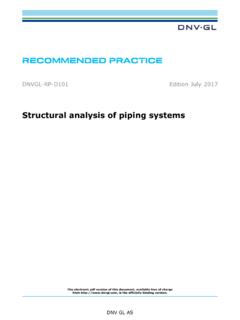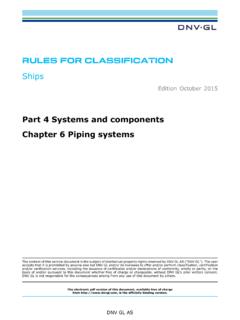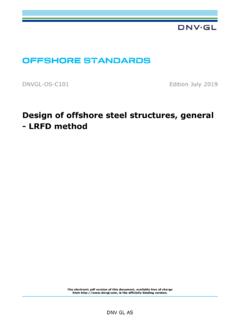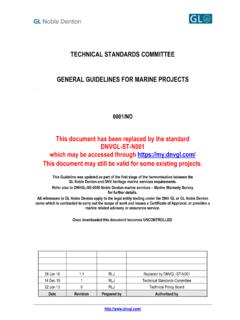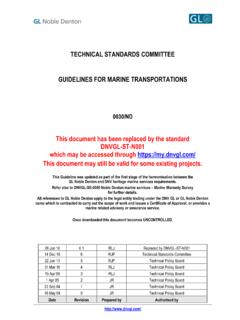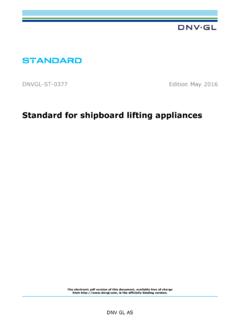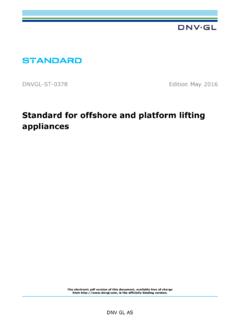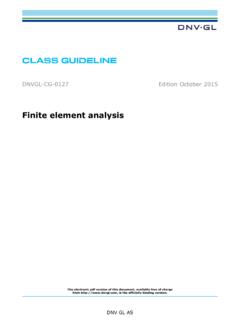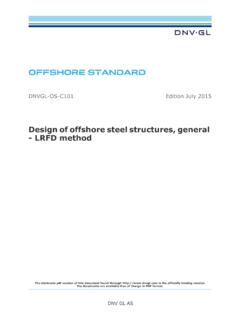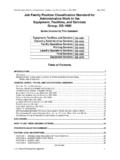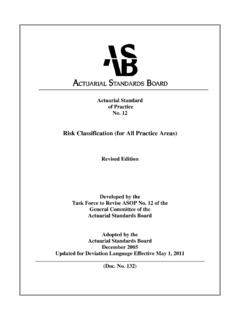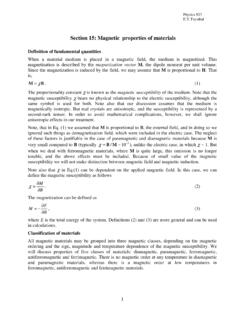Transcription of RULES FOR CLASSIFICATION Ships Part 3 Hull Chapter 3 ...
1 RULES FOR CLASSIFICATION . Ships Edition July 2017. Part 3 Hull Chapter 3 Structural design principles The content of this service document is the subject of intellectual property rights reserved by DNV GL AS ("DNV GL"). The user accepts that it is prohibited by anyone else but DNV GL and/or its licensees to offer and/or perform CLASSIFICATION , certification and/or verification services, including the issuance of certificates and/or declarations of conformity, wholly or partly, on the basis of and/or pursuant to this document whether free of charge or chargeable, without DNV GL's prior written consent. DNV GL is not responsible for the consequences arising from any use of this document by others. The electronic pdf version of this document, available free of charge from , is the officially binding version. DNV GL AS. FOREWORD. DNV GL RULES for CLASSIFICATION contain procedural and technical requirements related to obtaining and retaining a class certificate. The RULES represent all requirements adopted by the Society as basis for CLASSIFICATION .
2 DNV GL AS July 2017. Any comments may be sent by e-mail to If any person suffers loss or damage which is proved to have been caused by any negligent act or omission of DNV GL, then DNV GL shall pay compensation to such person for his proved direct loss or damage. However, the compensation shall not exceed an amount equal to ten times the fee charged for the service in question, provided that the maximum compensation shall never exceed USD 2 million. In this provision "DNV GL" shall mean DNV GL AS, its direct and indirect owners as well as all its affiliates, subsidiaries, directors, officers, employees, agents and any other acting on behalf of DNV GL. CHANGES CURRENT. Part 3 Chapter 3 Changes - current This document supersedes the January 2017 edition of DNVGL-RU-SHIP Changes in this document are highlighted in red colour. However, if the changes involve a whole Chapter , section or sub- section , normally only the title will be in red colour. Changes July 2017, entering into force as from date of publication Topic Reference Description Improvements to requirements to Table 1 The definition of applied corrosion detailed design.
3 Addition for prescriptive requirements for primary supporting members and strength assessment of FEM have been re-phrased. [ ] The tripping bracket requirement for inclined stiffeners are clarified with criteria for spacing and thickness of such tripping brackets, in line with requirements given in [ ] Criterion for brackets with unequal arm lengths is missing. The requirement given in CSR [ ]. is added, which give a small relaxation for such brackets with unequal arm lengths. [ ] Requirement to stiffening of PSM. end brackets have been simplified by removing duplicate requirement to stiffener area. In addition is the requirement to tripping stiffeners/. brackets clarified. For taper ratio between a wider flange and a narrower one has been relaxed from 1:4 to 1:3. in accordance with typical industry standard. [ ] The requirement to lightening holes in bracket floors is removed as this text is not necessary and creating misunderstanding. Editorial corrections In addition to the above stated changes, editorial corrections may have been made.
4 RULES for CLASSIFICATION : Ships DNVGL-RU-SHIP Edition July 2017 Page 3. Structural design principles DNV GL AS. CONTENTS. Part 3 Chapter 3 Contents Changes 3. section 1 1 8. 8. Certification 8. 2 Rolled steels for structural 8. 8. Material factor, 9. Steel Structures exposed to low air Through thickness Stainless 15. Cold formed 16. 3 Steel castings and forgings for structural 16. Rolled bars in lieu of steel 17. Steel castings for structural 17. 4 Aluminium 17. Extruded 17. Mechanical properties of weld 18. Material factor, 18. Connection between steel and 19. Aluminium 5 Steel sandwich panel 20. 20. 6 Other materials and 20. Iron cast 20. section 2 Net scantling 1 21. 21. Gross and net scantling Scantling 22. RULES for CLASSIFICATION : Ships DNVGL-RU-SHIP Edition July 2017 Page 4. Structural design principles DNV GL AS. Part 3 Chapter 3 Contents section 3 Corrosion 27. 1 27. 27. Corrosion addition 27. section 4 Corrosion 1 29. 29. Paint containing 29. 2 Sacrificial Attachment of anodes to the section 5 Structural 30.
5 1 30. 30. 2 General 30. Structural Longitudinal 30. Transverse 31. 31. Sheer 31. Stringer 31. Connection of deckhouses and 32. 3 Bottom 32. 32. 32. 33. Ships touching ground during loading and 33. 4 Aft 33. 33. Structural Stiffening of floors and girders in aft 34. 5 Engine 35. Bottom 35. Side 6 Fore 36. Floors and bottom RULES for CLASSIFICATION : Ships DNVGL-RU-SHIP Edition July 2017 Page 5. Structural design principles DNV GL AS. Wash Part 3 Chapter 3 Contents section 6 Detail 38. 1 Reinforcement of 38. Local 38. 2 40. Bracketed end connections of non-continuous 41. Connection of continuous 45. Sniped 47. Stiffeners on watertight 47. 3 Primary supporting members (PSM)..47. Web stiffening 47. Tripping bracket End 49. 4 5 Corrugated Corrugated 6 55. Openings and scallops in 55. Openings in primary supporting 56. Openings in strength deck, side shell, and longitudinal 58. section 7 Structural 65. 1 Structural idealisation of stiffeners and primary supporting 65. Effective 65. Spacing and load supporting 76.
6 Effective 77. Geometrical properties of stiffeners and primary supporting 81. 2 88. Idealisation of 88. Load calculation 3 93. Reference 93. Load calculation 94. 4 Primary supporting 95. RULES for CLASSIFICATION : Ships DNVGL-RU-SHIP Edition July 2017 Page 6. Structural design principles DNV GL AS. Load calculation Part 3 Chapter 3 Contents Changes 96. RULES for CLASSIFICATION : Ships DNVGL-RU-SHIP Edition July 2017 Page 7. Structural design principles DNV GL AS. section 1 MATERIALS. Part 3 Chapter 3 section 1. Symbols For symbols not defined in this section , see 1 General Introduction In this section requirements regarding the application of various structural materials are given. The requirements for manufacture, condition of supply, heat-treatment, testing, inspection, tolerances, chemical composition, mechanical properties, repair, identification, certification etc. shall in general comply with the requirements given in Certification requirements Rolled steel and aluminium for hull structures shall normally be supplied with the Society's material certificates in compliance with the requirements given in Requirements for material certificates for forgings, castings and other materials for special parts and equipment are stated in connection with the rule requirements for each individual part.
7 2 Rolled steels for structural application General Where the subsequent RULES for material grade are dependent on plate thickness, the requirements are based on the thickness as built. For vessels with L < 90 m, where the applied plate thickness is greater than that required by the RULES , a lower material grade may be applied, after special consideration. Young's modulus and Poisson's ratio The Young's modulus for carbon manganese steel materials and the Poisson's ratio to be used in the strength assessment are: 2. E = 206 000 N/mm = Steel material grades and mechanical properties Full details for requirements for materials are given in 2. Steel having a specified minimum yield stress of 235 N/mm is regarded as normal strength hull structural 2. steel. Steel having a specified minimum yield stress (ReH) in the range 235 < ReH 390 N/mm is regarded 2. as high strength hull structural steel. Steel having ReH > 390 N/mm is regarded as extra high strength structural steel. In the following, material grades of hull structural steels are referred to as follows: a) A, B, D, E and F denote normal strength steel grades.
8 B) AH, DH, EH and FH denote high strength and extra high strength steel grades, where H indicates the material strength. Normal strength is denoted NS and high strength steel and extra high steel are denoted HT. RULES for CLASSIFICATION : Ships DNVGL-RU-SHIP Edition July 2017 Page 8. Structural design principles DNV GL AS. Table 1 gives specified yield stress and tensile strength for rolled steels generally used in construction of Part 3 Chapter 3 section 1. Ships . Table 1 Mechanical properties of hull steels Steel grades for plates Specified minimum yield Specified tensile 2 2. with tas_built 150 mm stress ReH, in N/mm strength Rm, in N/mm A-B-D-E 235 400 - 520. A32-D32-E32-F32 315 440 - 570. A36-D36-E36-F36 355 490 - 630. A40-D40-E40-F40 390 510 - 660. A47-D47-E47-F47 460 570 - 720. Extra high strength steel 2. The application of extra high strength steel with ReH of 460 N/mm is limited to Ships with the class notation Container ship as defined in For other ship types, the application of this steel is considered on a case-by-case basis.
9 2. The application of extra high strength steel with ReH greater than 460 N/mm , will be considered on a case- by-case basis. Onboard documents It is required to keep onboard a plan indicating the steel types and grades adopted for the hull structures. Where steels other than those indicated in Table 1 are used, their mechanical and chemical properties, as well as any workmanship requirements or recommendations, shall be available onboard together with the above plan. Material factor, k Unless otherwise specified, the material factor, k, of normal and higher strength steel for hull girder strength and scantling purposes shall be taken as defined in Table 2. For intermediate values of ReH, k is obtained by linear interpolation. Table 2 Material factor, k 2. Specified minimum yield stress ReH, in N/mm k 235 315 355 390 460 RULES for CLASSIFICATION : Ships DNVGL-RU-SHIP Edition July 2017 Page 9. Structural design principles DNV GL AS. Part 3 Chapter 3 section 1. Steel grades Materials in the various strength members shall not be of lower grade than those corresponding to the material classes and grades specified in Table 3 to Table 10.
10 General requirements are given in Table 3, while additional minimum requirements are given in the following: Table 4: for Ships , excluding liquefied gas carriers covered in Table 5, with length exceeding 150 m and single strength deck. Table 5: for membrane type liquefied gas carriers with length exceeding 150 m. Table 6: for Ships with length exceeding 250 m. Table 7: for single-side Ships , single deck, no longitudinal bulkheads and with length exceeding 150 m. Table 8: for Ships with ice strengthening. The material grade requirements for hull members of each class depending on the thickness are defined in Table 9. RULES for CLASSIFICATION : Ships DNVGL-RU-SHIP Edition July 2017 Page 10. Structural design principles DNV GL AS. Table 3 Minimum material classes and grades Part 3 Chapter 3 section 1. Structural member category Material class/grade A1. Longitudinal bulkhead strakes, other than those belonging to the primary category Class I within L amidships Secondary A2. Deck plating exposed to weather, other than that belonging to the primary or special category Grade A/AH outside L amidships A3.
